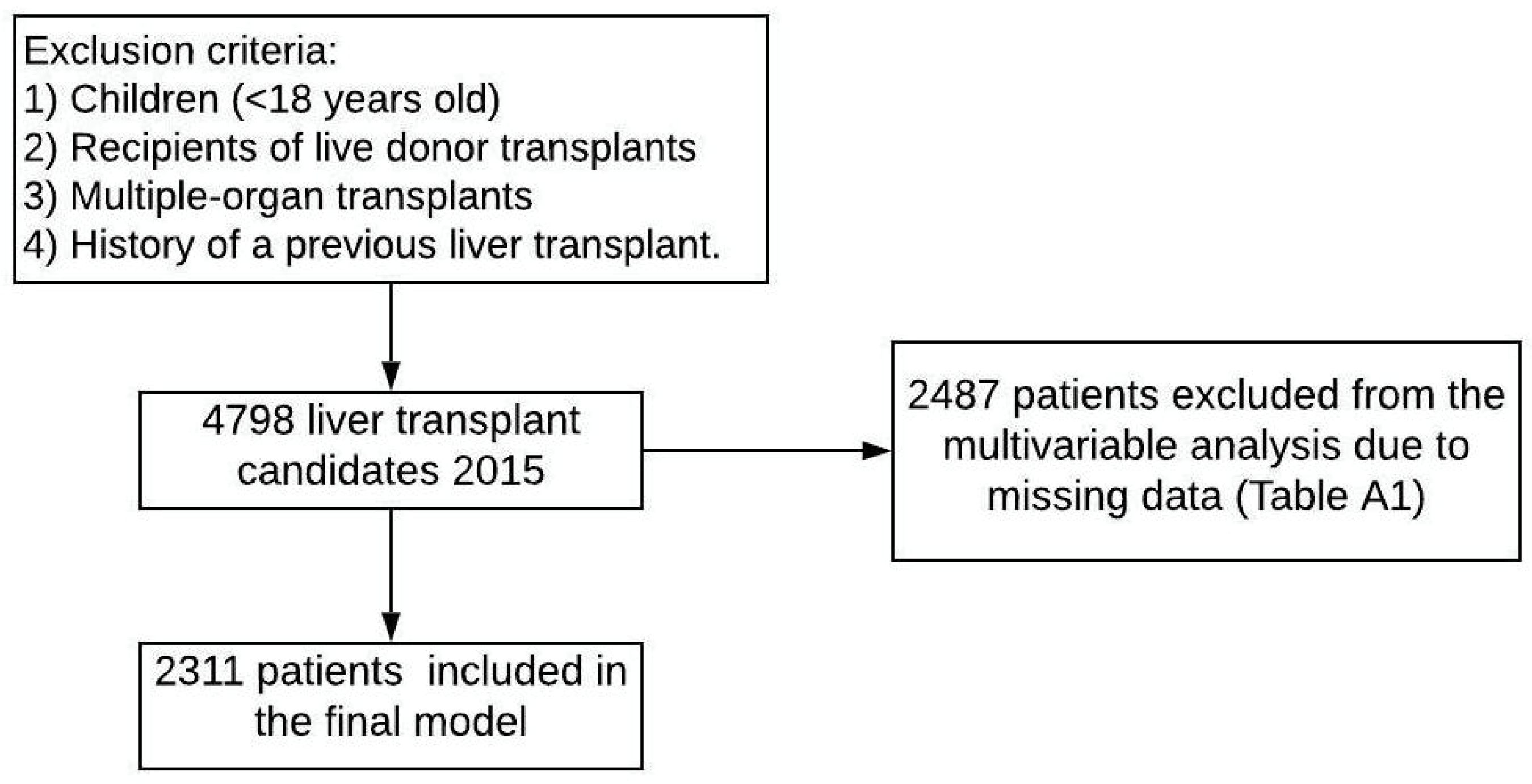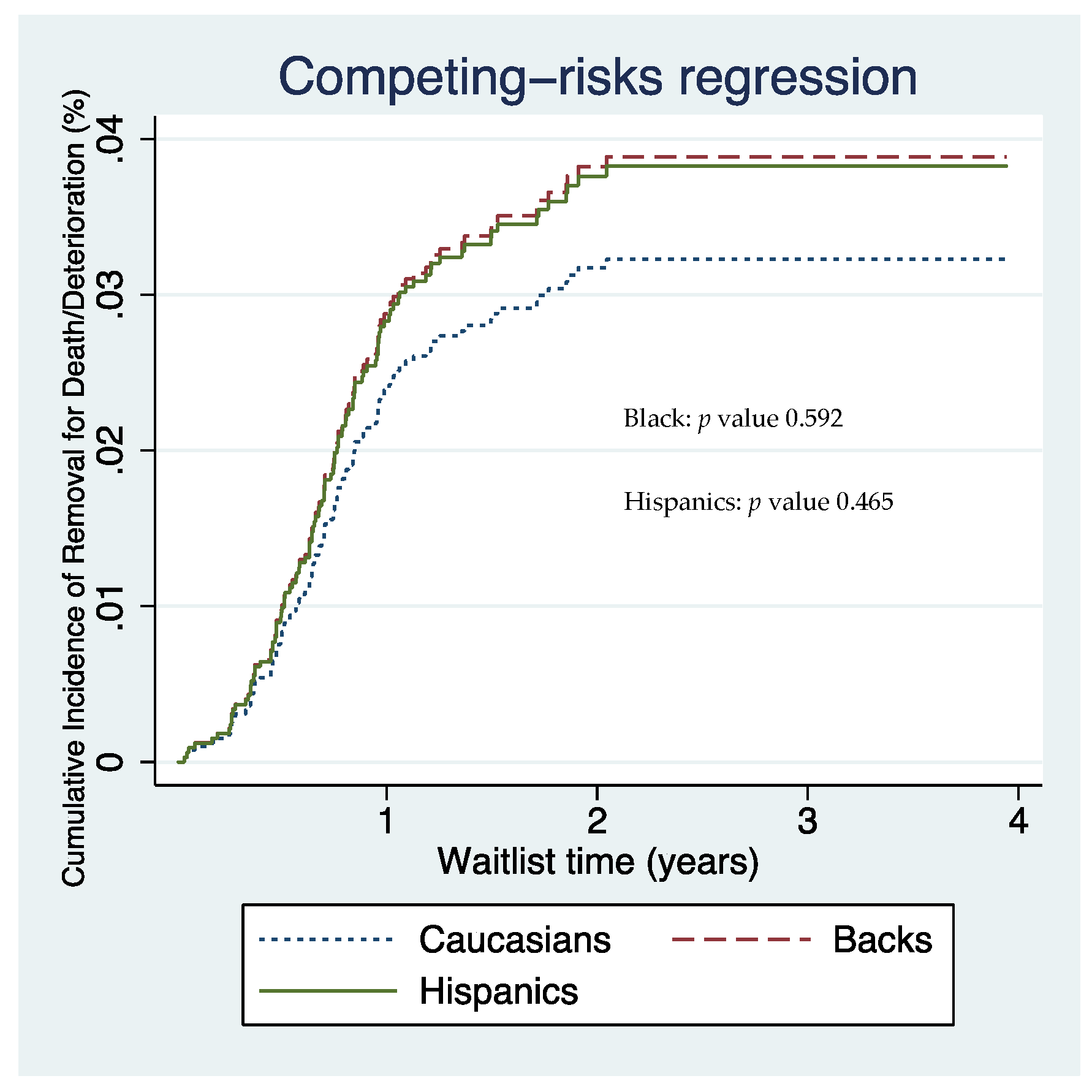Race/Ethnicity Is Not Independently Associated with Risk of Adverse Waitlist Removal among Patients with HCC Exception Points
Abstract
:1. Introduction
2. Materials and Methods
2.1. Study Population
2.2. Outcome
2.3. Study Variables
2.4. Statistical Analysis
3. Results
3.1. Characteristics of the Population: Descriptive Statistics
3.2. Waitlist Survival: Analytical Statistics
4. Discussion
5. Conclusions
Author Contributions
Funding
Institutional Review Board Statement
Informed Consent Statement
Data Availability Statement
Conflicts of Interest
Appendix A
| Variable Missing | Caucasian = 2034 | Black = 251 | Hispanic = 570 |
|---|---|---|---|
| Diabetes, n (%) | 6 (0.2) | 0 (0) | 7 (0.8) |
| AFP, n (%) | 552 (16) | 69 (16) | 174 (19) |
| Tumor size, n (%) | 1259 (37) | 147 (34) | 318 (34) |
| College, n (%) | 71 (2) | 13 (3) | 23 (2) |
| Locoregional therapies | 146 (8) | 22 (9) | 48 (10) |
References
- Braveman, P.; Gottlieb, L. The social determinants of health: It’s time to consider the causes of the causes. Public Health Rep. 2014, 129, 19–31. [Google Scholar] [CrossRef] [PubMed] [Green Version]
- Tang, A.; Hallouch, O.; Chernyak, V.; Kamaya, A.; Sirlin, C.B. Epidemiology of hepatocellular carcinoma: Target population for surveillance and diagnosis. Abdom. Radiol. 2018, 43, 13–25. [Google Scholar] [CrossRef] [PubMed]
- Lauren, D.; Nephew, M.; Marina Serper, M. Racial, Gender, and Socioeconomic Disparities in Liver Transplantation. Liver Transplant. 2021, 27, 900–912. [Google Scholar]
- Ha, J.; Yan, M.; Aguilar, M.; Tana, M.; Liu, B.; Frenette, C.T.; Bhuket, T.; Wong, R.J. Race/Ethnicity-specific Disparities in Hepatocellular Carcinoma Stage at Diagnosis and its Impact on Receipt of Curative Therapies. J. Clin. Gastroenterol. 2016, 50, 423–430. [Google Scholar] [CrossRef] [PubMed]
- Dakhoul, L.; Gawrieh, S.; Jones, K.R.; Ghabril, M.; McShane, C.; Orman, E.; Vilar-Gomez, E.; Chalasani, N.; Nephew, L. Racial Disparities in Liver Transplantation for Hepatocellular Carcinoma Are Not Explained by Differences in Comorbidities, Liver Disease Severity, or Tumor Burden. Hepatol. Commun. 2018, 3, 52–62. [Google Scholar] [CrossRef] [PubMed]
- Sobotka, A.L.; Hinton, A.; Conteh, L.F. African Americans are less likely to receive curative treatment for hepatocellular carcinoma. World J. Hepatol. 2018, 10, 849–855. [Google Scholar] [CrossRef] [PubMed]
- Nagai, S.; Kitajima, T.; Yeddula, S.; Salgia, R.; Schilke, R.; Abouljoud, M.S.; Moonka, D. Effect of Mandatory 6-Month Waiting Period on Waitlist and Transplant Outcomes in Patients with Hepatocellular Carcinoma. Hepatology 2020, 72, 2051–2062. [Google Scholar] [CrossRef] [PubMed]
- Heimbach, J.K.; Hirose, R.; Stock, P.G.; Schladt, D.P.; Xiong, H.; Liu, J.; Olthoff, K.M.; Harper, A.; Snyder, J.J.; Israni, A.K.; et al. Delayed hepatocellular carcinoma model for end-stage liver disease exception score improves disparity in access to liver transplant in the United States. Hepatology 2015, 61, 1643–1650. [Google Scholar] [CrossRef] [PubMed]
- Wong, R.J.; Cheung, R.; Ahmed, A. Nonalcoholic steatohepatitis is the most rapidly growing indication for liver transplantation in patients with hepatocellular carcinoma in the U.S. Hepatology 2014, 59, 2188–2195. [Google Scholar] [CrossRef] [PubMed]
- Goldberg, D.; Ditah, I.C.; Saeian, K.; Lalehzari, M.; Aronsohn, A.; Gorospe, E.C.; Charlton, M. Changes in the Prevalence of Hepatitis C Virus Infection, Non- alcoholic Steatohepatitis, and Alcoholic Liver Disease among Patients with Cirrhosis or Liver Failure on the Waitlist for Liver Transplantation. Gastroenterology 2017, 152, 1090–1099. [Google Scholar] [CrossRef] [PubMed] [Green Version]
- Ochoa-Allemant, P.; Ezaz, G.; Trivedi, H.D.; Sanchez-Fernandez, L.; Bonder, A. Long-term outcomes after liver transplantation in the Hispanic population. Liver Int. 2020, 40, 437–446. [Google Scholar] [CrossRef] [PubMed]
- Moylan, C.A.; Brady, C.W.; Johnson, J.L.; Smith, A.D.; Tuttle-Newhall, J.E.; Muir, A.J. Disparities in Liver Transplantation before and after Introduction of the MELD Score. JAMA 2008, 300, 2371–2378. [Google Scholar] [CrossRef] [PubMed] [Green Version]
- Sourianarayanane, A.; Aucejo, F.; Miller, C.; Lopez, R.; Zein, N.N.; McCullough, A.J.; Menon, K.V.N. Liver Transplantation for Hepatocellular Carcinoma among African Americans in the United States. Int. J. Organ Transplant. Med. 2012, 3, 85–91. [Google Scholar] [PubMed]
- Sokolich, J.; Buggs, J.; LaVere, M.; Robichaux, K.; Rogers, E.; Nyce, S.; Kumar, A.; Bowers, V. HCC Liver Transplantation Wait List Dropout Rates before and after the Mandated 6-month Wait Time. Am. Surg. 2020, 86, 1592–1595. [Google Scholar] [CrossRef] [PubMed]
- Estevez, J.; Yang, J.D.; Leong, J.; Nguyen, P.; Giama, N.H.; Zhang, N.; Ali, H.A.; Lee, M.-H.; Cheung, R.; Roberts, L.; et al. Clinical Features Associated with Survival Outcome in African-American Patients with Hepatocellular Carcinoma. Am. J. Gastroenterol. 2019, 114, 80–88. [Google Scholar] [CrossRef] [PubMed]
- Rosenblatt, R.; Wahid, N.; Halazun, K.J.; Kaplan, A.; Jesudian, A.; Lucero, C.; Lee, J.; Dove, L.; Fox, A.; Verna, E.; et al. Black Patients Have Unequal Access to Listing for Liver Transplantation in the United States. Hepatology 2021, 74, 1523–1532. [Google Scholar] [CrossRef] [PubMed]
- Wong, L.L.; Hernandez, B.Y.; Albright, C.L. Socioeconomic Factors Affect Disparities in Access to Liver Transplant for Hepatocellular Cancer. J. Transplant. 2012, 2012, 870659. [Google Scholar] [CrossRef] [PubMed] [Green Version]
- Sobotka, L.A.; Hinton, A.; Conteh, L.F. Insurance status impacts treatment for hepatocellular carcinoma. Ann. Hepatol. 2019, 18, 461–465. [Google Scholar] [CrossRef] [PubMed]
- Eckhoff, D.E.; McGuire, B.M.; Young, C.J.; Sellers, M.T.; Frenette, L.R.; Hudson, S.L.; Contreras, J.L.; Bynon, S. Race: A critical factor in organ donation, patient referral and selection, and orthotopic liver transplantation? Liver Transplant. Surg. 1998, 4, 499–505. [Google Scholar] [CrossRef] [PubMed] [Green Version]


| Descriptive Statistic | |||
|---|---|---|---|
| Variables | Caucasian n = 1645 (71) | Black n = 217 (9) | Hispanic n = 449 (19) |
| Age, median (IQR) | 62 (59–66) | 62 (59–65) | 61 (56–66) |
| Sex (male), n (%) | 1345 (82) | 154 (71) | 326 (73) |
| BMI, median (IQR) | 29 (26–33) | 29 (25–33) | 30 (26–33) |
| Blood type, n (%) | |||
| A | 693 (42) | 50 (23) | 154 (33) |
| B | 158 (10) | 49 (23) | 40 (9) |
| AB | 58 (4) | 8 (4) | 6 (1) |
| O | 736 (45) | 110 (51) | 249 (55) |
| Diabetes, n (%) | 562 (34) | 73 (34) | 215 (48) |
| Obesity, n (%) | 699 (42) | 89 (41) | 214 (48) |
| Ascites, n (%) | |||
| Absent | 1050 (64) | 171 (79) | 274 (61) |
| Slight | 527 (32) | 39 (18) | 151 (34) |
| Moderate | 67 (4) | 7 (3) | 24 (5) |
| Encephalopathy, n (%) | |||
| None | 1176 (72) | 175 (81) | 306 (68) |
| Grade 1–2 | 451 (27) | 42 (19) | 141 (31) |
| Grade 3–4 | 17 (1) | 0 (0) | 2 (0.45) |
| Underlying liver disease, n (%) | |||
| HCV | 893 (64) | 156 (84) | 207 (54) |
| ALD | 204 (15) | 15 (8) | 85 (22) |
| HBV | 25 (2) | 7 (4) | 2 (1) |
| NASH | 243 (17) | 2 (1) | 82 (21) |
| Cholestatic liver disease | 15 (1) | 3 (2) | 5 (1) |
| AIH | 15 (1) | 2 (1) | 5 (1) |
| MELD score at listing, median (IQR) | 9 (7–11) | 9 (7–11) | 10 (8–12) |
| UNOS region, n (%) | |||
| 1 | 57 (3) | 10 (5) | 7 (2) |
| 2 | 178 (11) | 31 (14) | 23 (5) |
| 3 | 282 (17) | 45 (21) | 66 (15) |
| 4 | 142 (9) | 28 (13) | 125 (28) |
| 5 | 171 (10) | 13 (6) | 126 (28) |
| 6 | 95 (6) | 2 (1) | 17 (4) |
| 7 | 143 (9) | 26 (12) | 24 (5) |
| 8 | 119 (7) | 7 (3) | 13 (3) |
| 9 | 60 (4) | 17 (8) | 26 (6) |
| 10 | 164 (10) | 15 (7) | 9 (2) |
| 11 | 234 (14) | 23 (11) | 13 (3) |
| Days on waitlist, median (IQR) | 244 (205–326) | 257 (209–357) | 290 (232–434) |
| AFP, (ng/mL) median (IQR) | 6 (4–12) | 9 (5–23) | 7 (4–17) |
| Tumor size (cm), median (IQR) | 2.6 (2.1–3.5) | 2.7 (2.1–3.6) | 2.8 (2.2–3.8) |
| Locoregional therapies, n (%) | |||
| Transarterial chemoembolization | 1078 (66) | 148 (68) | 316 (70) |
| Chemical ablation | 46 (3) | 5 (2) | 15 (3) |
| External beam radiation | 54 (3) | 2 (1) | 8 (2) |
| Radiation microspheres | 296 (18) | 39 (18) | 69 (15) |
| Thermal ablation | 529 (32) | 69 (32) | 143 (32) |
| Non-college education | 799 (49) | 128 (59) | 324 (72) |
| Multivariable Analysis | |||
|---|---|---|---|
| Variables | SHR * | 95% CI * | p Value * |
| Age | 1.01 | 0.98–1.05 | 0.275 |
| Sex (male) | 0.98 | 0.62–1.55 | 0.934 |
| Blood type | |||
| O | Ref | ||
| A | 1.19 | 0.80–1.79 | 0.379 |
| B | 0.39 | 0.15–0.99 | 0.049 |
| AB | 1 | 0.29–3.39 | 0.995 |
| Diabetes | 1.04 | 0.70–1.55 | 0.815 |
| Obesity | 1.03 | 0.69–1.53 | 0.874 |
| MELD score at listing | 1.1 | 1.07–1.15 | <0.001 |
| Ethnicity | |||
| Caucasian | Ref | ||
| Black | 1.20 | 0.60–2.41 | 0.592 |
| Hispanic | 1.18 | 0.74–1.88 | 0.465 |
| Tumor size | 1.06 | 1.01–1.12 | 0.019 |
| Alpha-Feto Protein | 1 | 0.99–1 | 0.196 |
| College Education | 1.35 | 0.89–2.03 | 0.150 |
Publisher’s Note: MDPI stays neutral with regard to jurisdictional claims in published maps and institutional affiliations. |
© 2021 by the authors. Licensee MDPI, Basel, Switzerland. This article is an open access article distributed under the terms and conditions of the Creative Commons Attribution (CC BY) license (https://creativecommons.org/licenses/by/4.0/).
Share and Cite
Goyes, D.; Nsubuga, J.P.; Medina-Morales, E.; Barba, R.; Patwardhan, V.; Saberi, B.; Fricker, Z.; Bonder, A. Race/Ethnicity Is Not Independently Associated with Risk of Adverse Waitlist Removal among Patients with HCC Exception Points. J. Clin. Med. 2021, 10, 5826. https://doi.org/10.3390/jcm10245826
Goyes D, Nsubuga JP, Medina-Morales E, Barba R, Patwardhan V, Saberi B, Fricker Z, Bonder A. Race/Ethnicity Is Not Independently Associated with Risk of Adverse Waitlist Removal among Patients with HCC Exception Points. Journal of Clinical Medicine. 2021; 10(24):5826. https://doi.org/10.3390/jcm10245826
Chicago/Turabian StyleGoyes, Daniela, John Paul Nsubuga, Esli Medina-Morales, Romelia Barba, Vilas Patwardhan, Behnam Saberi, Zachary Fricker, and Alan Bonder. 2021. "Race/Ethnicity Is Not Independently Associated with Risk of Adverse Waitlist Removal among Patients with HCC Exception Points" Journal of Clinical Medicine 10, no. 24: 5826. https://doi.org/10.3390/jcm10245826
APA StyleGoyes, D., Nsubuga, J. P., Medina-Morales, E., Barba, R., Patwardhan, V., Saberi, B., Fricker, Z., & Bonder, A. (2021). Race/Ethnicity Is Not Independently Associated with Risk of Adverse Waitlist Removal among Patients with HCC Exception Points. Journal of Clinical Medicine, 10(24), 5826. https://doi.org/10.3390/jcm10245826






